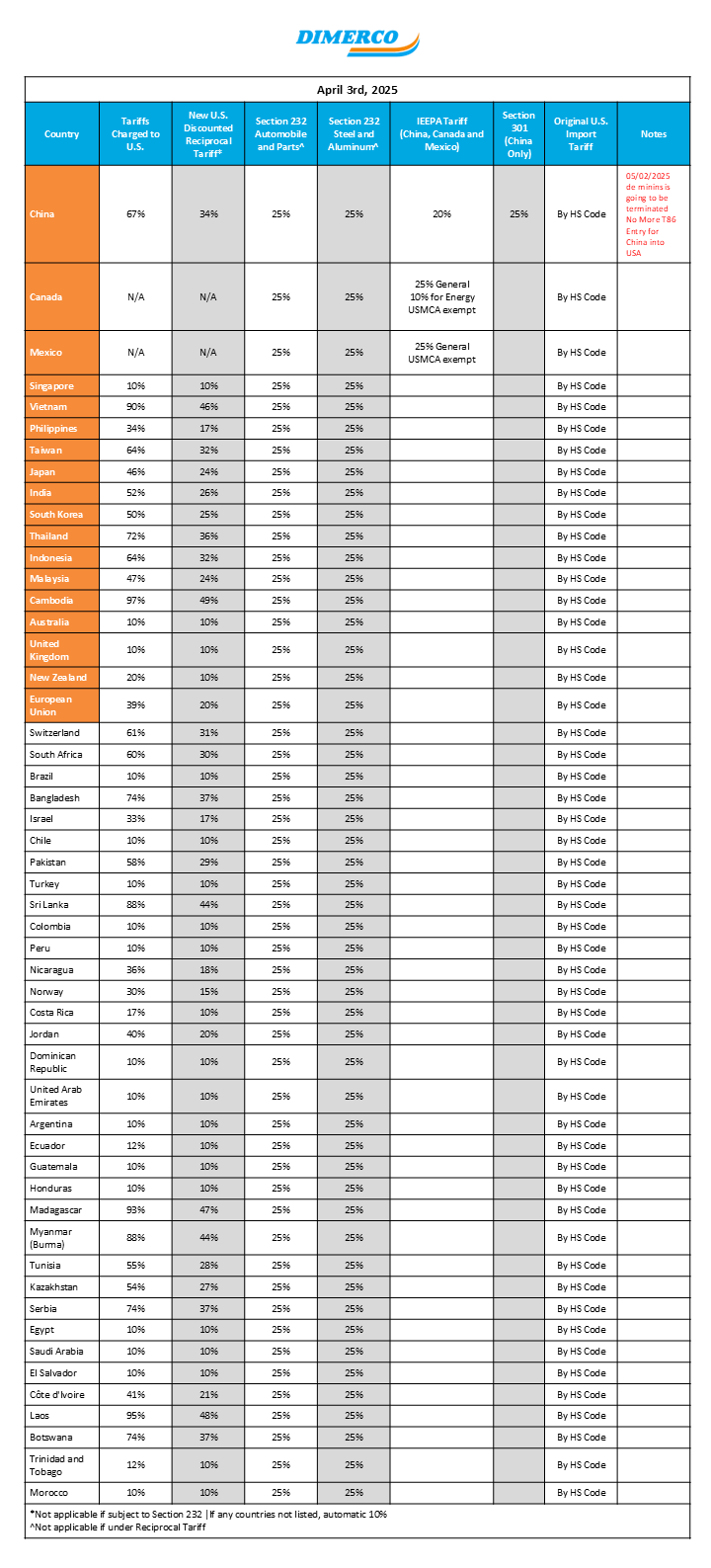Happening Now
President Donald Trump has announced new reciprocal tariffs on trade partners, with rates varying based on the trade deficit. Here’s a quick recap of the announcements from the White House.
10% Additional Tariff (April 5 Onward)
An additional 10% tariff applies to all countries, effective 12:01 AM EDT on April 5.
- Exemption: Shipments that depart their country of origin before this time are not subject to the 10% tariff.
Higher Country-Specific Duty Rates (April 9 Onward)
For countries with a reciprocal tariff rate above 10%, that higher rate will replace the 10% tariff on April 9 at 12:01 AM EDT.
- Exemption: Shipments that depart from origin before 12:01 AM EDT on April 9 are exempt.
- Clarification for China:
- For China (and by extension, Hong Kong and Macau), the rate rises from 10% on April 5 to 34% on April 9, unless action is taken to reduce the rate beforehand.
- Any country with a rate higher than 10% will follow this two-step increase schedule unless noted otherwise.
Find the quick breakdown below:
| Final Export Date | Tariff Applied | Notes |
|---|---|---|
| On or after April 5 and before April 9 | +10% Tariff | Applies to all countries uniformly |
| On or after April 9 | Reciprocal Tariff Rate | Country-specific rate applies. For China and by extension, Hong Kong and Macau): rises to +34% |
Exemptions from These Tariffs:
These new duties do not apply to:
- Products already covered by the February 10 steel & aluminum tariff order.
- Automobiles and parts covered by the March 26 order.
- Specific industries: copper, pharmaceuticals, semiconductors, lumber, critical minerals, and energy products.
- Countries under Column 2 duty rates (those without Normal Trade Relations).
- Future Section 232 products.
USMCA Exemptions and Special Cases:
- The 25% tariff exemption for Canada (CA) and Mexico (MX) is extended.
- Non-USMCA goods from CA/MX still face a 25% tariff.
- Non-USMCA energy products from CA/MX are subject to a 10% tariff.
- Reciprocal tariffs do not apply to CA/MX—the new 10% tariff is not added to the existing 25% rate.
- If existing CA/MX orders are canceled or suspended, then USMCA-qualifying goods and energy/potash resources will not face reciprocal tariffs. Non-qualifying goods will be subject to a 12% tariff. (Reciprocal tariffs apply only to non-US content if at least 20% of the article’s value originates in the US.)
Additional Requirements:
- Goods subject to these duties must enter FTZs under privileged foreign status.
- Items covered by the new tariffs are eligible for de minimis treatment until the Secretary of Commerce finalizes systems for duty collection.
De Minimis Ban for China and Hong Kong – Effective May 2, 2025
On April 2, President Trump signed an Executive Order ending duty-free de minimis treatment (for shipments under 800 USD) for goods originating from China and Hong Kong, effective 12:01am EDT, May 2, 2025. This includes packages shipped via international postal services.
- Full duties (base + Section 301, 232, and IEEPA) will apply.
- Formal entry and duty payment is required for all affected shipments.
- Macau may be added to this ban pending further review.
- Postal carriers must either: Pay 30% of declared value per package, or Pay a 25 USD fee per item starting May 2, increasing to 50 USD per item starting June 1.
- Carriers must post a bond and comply with enhanced reporting.
This policy change ends de minimis exemptions for low-value goods from China and Hong Kong, affecting e-commerce and small parcel flows to the U.S.
Possible Future Adjustments:
- If a country retaliates with tariffs on US exports, US tariffs may increase or expand.
- If countries adjust to create fairer trade, the US may reduce or limit duties.
- If US manufacturing weakens further, the US may increase tariffs under the order.
Example: How New Tariffs Impact Duty & Tax Calculation
Below is a sample breakdown for products classified under HTSUS 8538.90.8180, showing how tariffs may vary depending on country of origin and export date.
Country of Origin: China
- If final export date on or before April 4: General 3.5% + Section 301 China 25% + IEEPA China 20% → Total: 48.5%
- If final export date on/after April 5 but on/before April 8: General 3.5% + Section 301 China 25% + IEEPA China 20% + IEEPA Reciprocal 10% → Total: 58.5%
- If final export date on/after April 9: General 3.5% + Section 301 China 25% + IEEPA China 20% + IEEPA Reciprocal 34% → Total: 82.5%
Country of Origin: India
- If final export date on or before April 4: General 3.5% → Total: 3.5%
- If final export date on/after April 5 but on/before April 8: General 3.5% + IEEPA Reciprocal 10% → Total: 13.5%
- If final export date on/after April 9: General 3.5% + IEEPA Reciprocal 26% → Total: 29.5%
Recommendation
- Book shipments now if your inventory and supplies are ready, as air freight capacity is expected to be tight. Partner with a reliable freight forwarder, like Dimerco, to secure space.
- Utilize Free Trade Zones (FTZs) to defer duty payments until products are sold, improving cash flow management.
- Review U.S. trade compliance basics to stay informed on the latest regulations. Consult a trade compliance expert, like Dimerco, for guidance on navigating current policies. Listen to our recent podcast featuring recognized experts on U.S. tariffs and trade compliance for latest insights.

